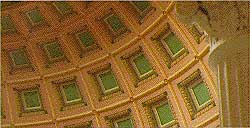
The Office of the Secretary of the Navy, ca. 1905.
U.S. Naval Institute.
Many of our most celebrated national figures have participated in
historical events that have taken place within the EEOB's granite walls.
Theodore and
Franklin D. Roosevelt,
William Howard Taft,
Dwight D. Eisenhower,
Lyndon B. Johnson,
Gerald Ford, and
George H.W. Bush all had offices
in this building before becoming President. It has housed 16 Secretaries
of the Navy, 21 Secretaries of War, and 24 Secretaries of State. Winston
Churchill once walked its corridors and Japanese emissaries met here with Secretary of
State Cordell Hull after the bombing of Pearl Harbor.
President Herbert Hoover
occupied the Secretary of Navy's office for a few months following a fire in
the Oval Office on Christmas Eve 1929. In recent history, President
Richard Nixon had a private
office here. Vice President
Lyndon B. Johnson was the
first in a succession of Vice Presidents to the present day that have had
offices in the building.

West Rotunda, restored in 1987. Extensive research was conducted to
determine the colors of the stained glass that was removed in 1950.
Walter Smalling, Jr.

The Executive Office of the President Law Library was originally the
War Department Library. This room mixes motifs derived from several
architectural styles and, although it looks like a mixture of
different metals, is composed entirely of cast iron.
Walter Smalling, Jr.
The French Second Empire style originated in Europe, where it first appeared
during the rebuilding of Paris in the 1850s and 60s.
Based upon French Renaissance prototypes, such as the Louvre Palace, the Second Empire
style is characterized by the use of a steep mansard roof, central and
end pavilions, and an elaborately sculptured facade.
Its sophistication appealed to visiting foreigners, especially in England and
America, where as early as the late 1850s, architects began adopting
isolated features and, eventually, the style as a coherent whole. Alfred
Mullett's interpretation of the French Second Empire style was, however,
particularly Americanized in its lack of an ornate sculptural program
and its bold, linear details.

Theodore Roosevelt served as Assistant Secretary of the Navy under
John D. Long prior to the Spanish-American War.
Library of Congress.
North wing dome. Paint analysis revealed differences in coloration
corresponding to the differences in design in the two pairs of domes and
led to their restoration in 1984.
Walter Smalling, Jr. 
Original painted decoration on the coved ceiling in the office
of the Secretary of the Navy.
Walter Smalling, Jr. The building was designated a National Historic Landmark in 1969.
In 1972, it was listed on the National Register of Historic Places and
the District of Columbia Inventory of Historic Sites.

Office of the Secretary of the Navy restored 1987. Restoration
included partial replication of original marquetry floor.
Walter Smalling, Jr. In 1988, Congress enacted legislation to allow the Office of
Administration to accept gifts and loans from the public on behalf of the
EEOB to be used for preservation and restoration purposes. Persons
interested in finding out more about the preservation program or in
making a contribution should contact the Preservation Office.

Office of the Secretary of War, 1888. It is typically victorian in
style, with a parquet floor, heavy wall coverings, and an intricate
ceiling mural.
Library of Congress. |











